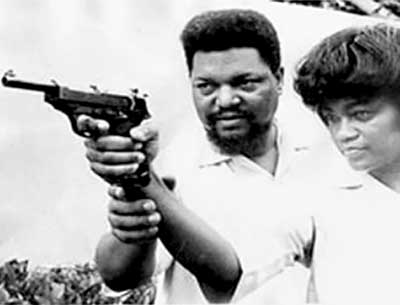

Robert F. Williams
Monroe, N.C. — What has changed? What has remained the same?
That’s what we asked ourselves as the four of us — two African Americans, two whites — piled into a car in mid-August and drove to Monroe from Charlotte, N.C. We had been helping to build the March on Wall Street South taking place during the Democratic National Convention in early September. We’d also participated in a one-week school on Marxism attended by a great group of young activists, most from the South.
This writer had last been in Monroe in 1962, when it was a hot spot in the Black Freedom struggle. Freedom Riders had come through there the summer before. Most challenging to the racist power structure was the stand taken by the head of the local NAACP branch, Robert F. Williams, in motivating and organizing for armed self-defense of the Black community.
Steve Millies wrote in a 1996 obituary of Williams for Workers World: “On too many Saturday nights, KKKers would drive through the Black community, shooting it up. … When North Carolina Gov. Luther Hodges did nothing to stop the attacks, Williams and the local NAACP chapter formed a National Rifle Association chapter and trained its members in using firearms. In the summer of 1957, a Klan motorcade attacked the home of NAACP member Dr. Albert E. Perry. An armed defense squad drove them off. Klan night riding came to a sudden stop in Monroe.”
Williams also preached what he practiced. He became known nationally for politically defending the right of self-defense — a right that, even though it is acknowledged by law, had in fact been denied the oppressed Black nation.
In 1961, racist violence against the Freedom Riders was at its peak. Williams and several others were hit with a bogus charge of kidnapping. One of those indicted was Mae Mallory, whom I had met earlier that year in New York while protesting the assassination of Congo leader Patrice Lumumba. Both Williams and Mallory, in fear of their lives, escaped from Monroe.
Williams made it to Cuba and then to China. Decades later, he came back to the U.S. and the state dropped the phony charges against him. Mallory spent almost two years in jail in Cleveland, where the Monroe Defense Committee carried out a vigorous campaign against her extradition to North Carolina. It was representing the MDC that three of us — two Black, one white — had driven from New York to Monroe in 1962 to support Williams and Mallory.
Twenty-first century racism
Unlike that trip of half a century ago, this year we didn’t have to conceal the fact that Blacks and whites were traveling together in the same car. On the approach to Monroe, everything looked different. Where a winding country road had once bordered the town, there was now a new four-lane divided highway flanked by endless chain stores and bank branches.
I was looking for something familiar, something to jog my memory. We found it when we got to an older neighborhood next to the railroad tracks. There was the Monroe I remembered from 1962 — small, white clapboard houses, now 50 years older but still with neat front lawns. Inside had been only the barest sticks of furniture. At that time, the only jobs Black men could get in the textile mills were as sweepers. The only jobs for Black women were as domestic workers for $15 a week.
Today, the mills are shuttered and crumbling. We asked an African-American man in a fish store about jobs. He shook his head, “There are no jobs.”
On the other side of the tracks, the houses are larger, newer, some made of brick. We found the library, a new building with a section on Monroe’s history. A white librarian told us proudly of being on a march last year to commemorate the 50th anniversary of the Freedom Rides. How much has changed? She lowered her voice. “There are still some who won’t let go.”
Those “some” wield a lot of power. So much so that recent efforts to commemorate enslaved people who died while being forced to serve their “masters” in the Civil War ran into fierce resistance. The “some” didn’t want any monument to Black people in Union County, N.C., including for those who fought for the Confederacy.
There may not be cross-burnings in Monroe today, but the African-American community still knows terror. It’s the economic terror of a white boss deciding whether you work or not. And it’s the police terror that upholds the bosses and fills the jails with people of color. There won’t be any “post-racial society” in the U.S. until this terror has been eradicated.
Raposo is a Portuguese Marxist analyst, editor of the web magazine jornalmudardevida.net, where this article…
By Alireza Salehi The following commentary first appeared on the Iranian-based Press TV at tinyurl.com/53hdhskk.…
This is Part Two of a series based on a talk given at a national…
Educators for Palestine released the following news release on July 19, 2025. Washington, D.C. Educators…
On July 17, a court in France ordered the release of Georges Abdallah, a Lebanese…
The following are highlights from a speech given by Yemen’s Ansarallah Commander Sayyed Abdul-Malik Badr…